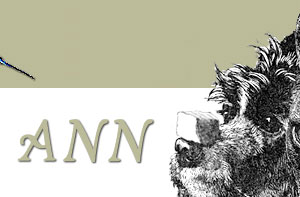). The training going on, what there was of it, was not too bad. What struck me, after just a few minutes, was how much down-time there was. Trainers were discussing various and sundry things, sometimes important training things, but often about social and personal things. All the while the people were "discussing," the dogs were doing there own thing, including a whole bunch of sniffing, but also looking at animal life (we were in a rather remote park, with lots of squirrels, birds and other interesting things).
Funny thing, when the trainers were ready to go, the dogs took several minutes to get back to work. I watched dogs stop in the middle of a ladder and look intently into the trees. I watched other dogs stop at the base of an A frame and intently sniff where other dogs had run, and on and on this sort of behavior went; for the rest of the afternoon. The trainers were very disappointed at the training progress, and they spent a lot of time discussing amongst themselves about how slow the dogs were.
At the end of the training period, I was asked what I thought. First, and those who know me will understand, I said that I knew nothing about competitive agility. I did make a few observations about timing and criteria, and they all looked at each other and shook their heads in understanding. A few murmured that they would do better. But, I then came to the RATE OF REINFORCEMENT, and what I said was that the dogs were a reflection of the trainers (or, rather, the behavior of the dogs was simply a reflection of the behavior of the trainers). I told them that, to me, they were not seriously training, and that the dogs were not seriously training either. The dogs should hit the ground running, and everything, including the trainers, should be double time or stopped, for rest. When resting, the dogs should be moved somewhere else. Socialializing, discussions, even training discussions should be held outside the area. The dog's playtime should be somewhere else. I went on in more detail, but you folks get the idea.
Some weeks later, I bumped into one of the group in town. She told me that there last two training club meeting were fantastic. Most of the dogs were going through the course much faster, and there were very few distracted dogs.
Those of you who have been to our workshops know that one thing we try to get across very early in our intro class is learning to focus and keep things moving at a high rate, including the pace of reinforcement. We are used to moving slowly. We forget sometimes that we set the pace. When we slow down, the dog will slow down. When we speed up, don't expect the dog to suddenly speed up too. The dog has already discovered another world that, for the time being, is more worthwhile paying attention to than you. It is not the dog's fault. We let it happen, maybe even encouraged it.
So, try working in VERY short, VERY fast bursts for a while. When not working, move IMMEDIATELY out of the work area. When restarting, start with a bang, and keep the dog moving. The slightest hint of distraction, move the dog out of the work area, find a wall and bang your head three times, and then go back to work, double-time.
Give it a try.
Reprinted with permission Copyright 2001
Bob Bailey


